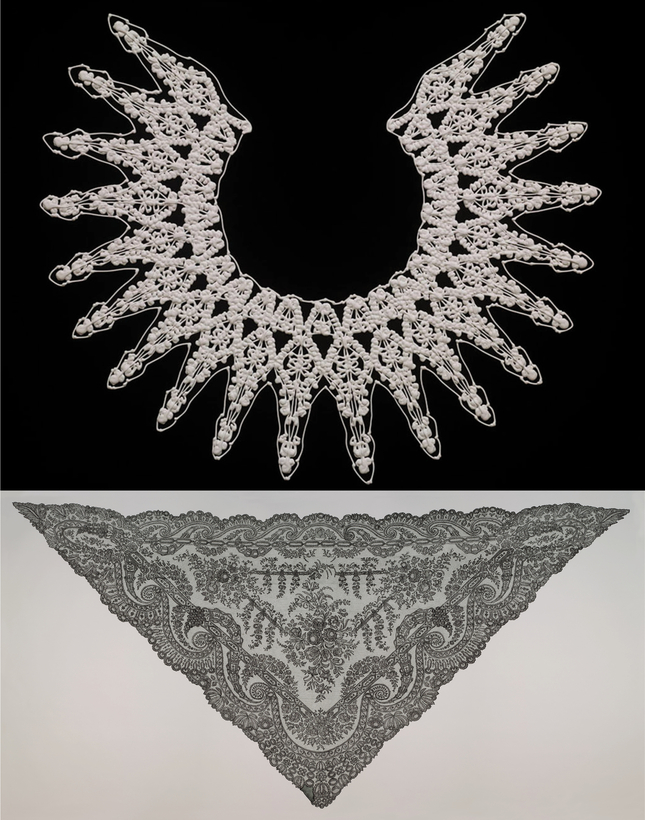My mother’s white lace wedding dress lived in the basement of my grandparents’ suburban-Detroit home. My childhood summers were spent in that house, and soon after arriving I would scurry downstairs to the fragrant, cedar-lined closet to gaze again at the stark purity of the threads, a snowflake pattern that was wildly delicate yet forever unmelting. Like all lace, it radiated both earthly treasure and pristine transcendence. One summer I arrived to find it was gone—the basement had flooded and the dress was among the casualties. I have mourned it ever since.

Fast-forward to the present, and the new exhibition at the Bard Graduate Center “Threads of Power: Lace from the Textilmuseum St. Gallen,” opening September 16. While it may not include that dress lost long ago, the show—co-curated by Emma Cormack, associate curator at the Bard Graduate Center; Michele Majer, a B.G.C. assistant professor; and Ilona Kos, curator at the Textilmuseum St. Gallen—offers more than enough to ignite the heart and mind of any lace-lover.
About 200 pieces are on display, ranging from a geometrically rigorous cone-shaped bobbin-tape-lace collar to a needle-lace mantelet that drapes gracefully over the wearer’s back and shoulders, to an Yves Saint Laurent evening dress from 1963, a delectable confection of cotton, silk, pearl, and—who would have guessed?—plastic.

The show charts lace’s journey around the world, starting in St. Gallen, a city on the edge of Lake Constance in eastern Switzerland, where the humid climate was an advantage in growing linen—lace’s raw material. From there, we follow the production from Italy to Spain, Spanish America, Peru, France, Belgium, England, and America. Eventually, the rapacious mechanization of the industrial age transformed the lace industry: machine-made lace turned what was once rarefied and exclusive into a far more affordable and attainable commodity.
We know much more about the consumers of lace—royalty, aristocrats, highly placed members of the clergy—than we do about its producers. The former appear in portrait after portrait, their lavishly lace-trimmed clothing an almost angelic enhancement of their special status. In contrast, the women who engaged in the painstaking work of making lace by hand—this was a highly gendered profession—lived and labored in humble and often precarious circumstances. Their representation is limited to anonymous appearances in genre painting. Their work was unsigned, and their names are one with the mist.

For those who may consider lace a fusty artifact from long ago, Cormack notes that “there is an active global community of lace-makers using the same 16th-century techniques to create lace. Many makers use the medium to express ideas about gender, community, and identity.” As is happening with so many guild crafts, not to mention female art forms, a new generation, Cormack says, is “reimagining this historical textile for the present.”
Consider the specially commissioned bobbin-lace collar made by the contemporary lace-maker Elena Kanagy-Loux (who notably made a lace collar for Ruth Bader Ginsburg’s 25th anniversary as a Supreme Court justice).

“The collar incorporates figural scenes from the Old Testament story of the widow Judith beheading the Assyrian general Holofernes,” explains Cormack, “imagery that appears in several examples of antique needle lace.” Kanagy-Loux was intrigued that this violent story had been depicted by numerous historical lace-makers (the exhibition includes an example from the early 1600s), and her creation features the large scallops of a 17th-century Genoese lace collar. The 21st-century difference? “Rather than the traditional white of antique lace,” says Cormack, “Elena’s piece is made in a striking red silk.” —Yona McDonough
“Threads of Power: Lace from the Textilmuseum St. Gallen” is on at the Bard Graduate Center, in New York City, beginning September 16
Yona McDonough is the author of several novels, including The Doll with the Yellow Star and The Bicycle Spy


 Discover
Discover